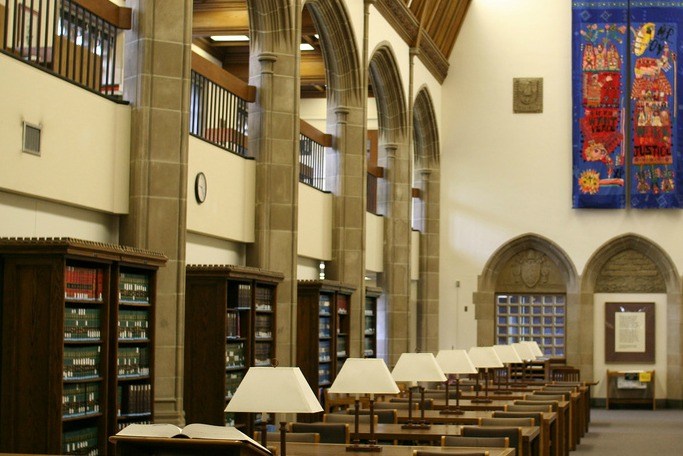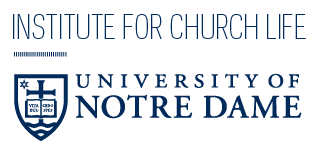These are challenging days for those doing the work of undergraduate education, and perhaps especially so for those who mean to pursue that work in light of the Gospel. In the midst of economic challenges, we must ask again what the real purpose of a college education is. How should we think about the classical project of the liberal arts? What about ongoing challenges in making education available to students who are economically and culturally disadvantaged?
For those in a religious context, another set of equally important questions must be asked. What are the crucial markers of mission and identity? What should be the composition of the “core” of courses required for graduation? On Catholic campuses, it’s asked whether a certain percentage of the faculty must be Catholic or how sacramental life can be fostered on campus. These are not questions that can be simply ignored. The publication of Evangelii Gaudium, Pope Francis’ first Apostolic Exhortation, does, however, present new possibilities. What if we were to reframe the questions in light of the concerns the Holy Father elucidates? Here, as in so many other situations, I believe we will find that Pope Francis offers ways in which the conversation might be transformed. It remains the case that specific initiatives and decisions must be worked out at the local level, but the central emphases of Evangelii Gaudium offer a new set of priorities to consider, and perhaps a path to deeper grounding of Christian undergraduate education. These new possibilities become especially clear, I’ll argue, when we read Evangelii Gaudium in light of one crucial prior influence, that of Msgr. Luigi Giussani.
Encounter with Christ
Within the first few paragraphs of Evangelii Gaudium, Pope Francis issues the invitation that governs its pages: “I invite all Christians everywhere, at this very moment, to a renewed encounter with Jesus Christ” (Evangelii Gaudium, §3). This invitation to immediate and personal encounter with Christ goes, of course, to the heart of the Christian way. It reflects deeply not only the narratives of the Gospels, but also the particular spirit of the Ignatian spirituality that deeply shaped Jorge Bergoglio as a Jesuit. This first word makes apparent that any fully Christian endeavor will never be merely intellectual, never be a coldly cerebral enterprise, but will take a personal form.
It is not immediately clear, however, what it might mean to bring this call to the college campus. In what sense is a direct encounter with Christ the end of the university as such? How would this be worked out in varying fields of study? What are the implications for faculty or students who are not Christian? It is crucial that we begin by noting that what Pope Francis describes is not just a discrete individual encounter with Christ, but also the cultural embodiment of that encounter. He sketches the possibility that the encounter with Christ is refracted in a thousand ways, creating concrete, lived realities that reflect that initial moment. When the encounter with Christ is expressed in this broader way, we see something in which a wide variety of people can participate, something that might shape the whole community of a college campus in profound ways.
We also begin to see in these emphases an influence that stands behind the pages of Evangelii Gaudium, one that may make its implications for undergraduate education even clearer: the work of Msgr. Luigi Giussani. Best known as the founder of the ecclesial movement Communion and Liberation, Giussani is clearly an important influence on Fr. Jorge Bergoglio, SJ, the man who would become Pope Francis. In his years in Argentina, Bergoglio became close to the Communion and Liberation movement, sometimes speaking at its annual meeting.[1] And he studied Giussani’s own work carefully, contributing, for example, a chapter to a book that explored one of Giussani’s works at length.[2] One of Giussani’s strongest emphases is this lived, communally shared experience. In his book The Journey to Truth is an Experience, Giussani explicitly describes such an experience in an educational setting:
Ideas, even if sublime and well expressed, do not educate unless they are seized within a lived experience. Thus the educational relationship is that of an experience lived together; the educative dialogue must be understood as a gesture in common.[3]
If, then, the encounter with Christ would become a “gesture in common” on our college campuses, what might characterize that gesture? Evangelii Gaudium suggests at least three specific ways in which the encounter with Christ is inextricably connected to three other sorts of encounters: an encounter with those on the margin, an encounter with one another, and an “encounter” with ourselves.
Encounter with Those on the Margin
Pope Francis’ emphasis on reaching out to those who are marginalized—shown both in his teaching and his actions—is perhaps the most widely noted characteristic of his pontificate thus far. It is no surprise that it appears in Evangelii Gaudium as well: “All of us are asked to obey his call to go forth from our own comfort zone in order to reach all the ‘peripheries’ in need of the gospel” (EG §20). Here is a reminder of Christ’s own commitment to those on the margins, and a special reminder to academic communities: any who have the opportunity for study enjoy remarkable privilege, and are called to go out from that “center” of privilege to the margins, where they will inevitably feel less comfortable.
 |
| A Notre Dame undergraduate shares a smile with a camper while serving at Camp Albrecht Acres in Dubuque, Iowa. Photo courtesy of the Center for Social Concerns. |
Especially in our day, Pope Francis argues, human beings are increasingly treated not as human beings at all, but as “consumer goods to be used and then discarded” (EG §53). This, he argues, is something even worse than “exploitation.” It is rather a dynamic by which certain people simply slip from view altogether, and are “excluded” in an extreme and thoroughgoing way.
In one sense, this is already a concern on U.S. college campuses—one that is growing more prominent all the time. Service projects, service trips during school breaks, “service-learning,” and other forms of practical outreach are growing practices on our campuses, and many students take advantage of these opportunities. Evangelii Gaudium challenges us to go further, though, and here is where a new set of questions at the heart of the university begins to appear. How can members of the academic community—including faculty, students, and others—“go out” in a way proper to the life and purpose of the university? How can such efforts be integrated—through study, reflection, and action—into the ongoing reality of campus life? Evangelii Gaudium warns that even when we do “go out” to the margins, we nevertheless may not be truly moved or truly changed by that encounter, and “lives stunted for lack of opportunity seem a mere spectacle” (EG §40). We begin to see the contours of a new, deeply challenging, and possibly life-giving, set of questions.
Encounter with One Another
As challenging as it is to “go out” in this way to those on the margins, however, a second call appearing here may prove even more difficult. Evangelii Gaudium is clear that the culture of encounter with Christ means a commitment to encounter with each other. The divisive politics that can exist on the college campus are, unfortunately, only too well known. How much easier it is, in some cases, to “go out” to a far distant point than to go across the hallway to greet a colleague who has become an opponent. The section of Evangelii Gaudium entitled “No to Warring Among Ourselves” (§§98–101), at first glance a dramatic warning, appears in such a context completely appropriate. “How many wars take place within the people of God and in our different communities!”
Pope Francis says. “In our neighborhoods and in the workplace, how many wars are caused by envy and jealousy, even among Christians!” (EG §98). And even when there is no outward, direct conflict, we may see our communities fractured into an isolated campus, divided in educational settings by discipline, by ideology, by the sort of service various individuals provide to the community. In how many places do we see those in the “sciences” at odds with those in the “liberal arts,” or faculty who have little regard for staff, or students who gather into homogenous subgroups, never truly encountering the student sitting next to them? If we tend to treat those on the margins as if they do not exist, as merchandise to be thrown away if it does not meet our needs, how much more scandalous is it if we demonstrate the same tendencies with those in immediate proximity? “Let us ask the Lord to help us understand the law of love,” Pope Francis here urges. “How much good it does us to love one another, in spite of everything. Yes, in spite of everything! . . . Let us not allow ourselves to be robbed of the ideal of fraternal love!” (EG §101).
Turning again to Luigi Giussani allows us to see more clearly the imperative involved in this call to encounter with each other, as he considers its importance for education. After all, he argues,
The value of an education is measured by how closely and obediently it follows reality, how much attention it calls to it, and how closely it follows even its faintest indications. First among these indications is a person’s original need for dependence and the patience that a growing process requires.[4]
Any who have the opportunity for study enjoy remarkable privilege, and are called to go out from that “center” of privilege to the margins, where they will inevitably feel less comfortable.
Insofar as a college education is intended to prepare students to go out into the world, this encounter with the other—even the other with whom one is in conflict—is indispensable. “In this possibility that Christ gives us of welcoming others into our lives,” Giussani writes, “a different brand of humanity becomes visible, when men and women can finally breathe to their fullest extent.”[5] Encounter with one another is not simply a way of setting the stage for the work of education, but it is an integral part of that work. If we are to accomplish well the task of living the Gospel of joy in a context of undergraduate education, each of us and all of us must consider that the “gesture” of education is indeed one that is lived out “in common.”
“Encounter” with Ourselves
A third “encounter” is perhaps not an encounter in the proper sense, but it is central to Evangelii Gaudium and important to mention in connection with the other forms of encounter previously described. Both in this document and elsewhere,[6] Pope Francis has noted the dangers, especially connected with newer technology and social media, of constant distraction—an overwhelming flow of information and options that leaves us unable to focus our thoughts and energies. He observes, “Sometimes we prove hard of heart and mind; we are forgetful, distracted and carried away by the limitless possibilities for consumption and distraction offered by contemporary society. This leads to a kind of alienation at every level” (EG §196).
In a sense, the “encounter with oneself” is intimately connected to one of the most foundational purposes of the academy: theoria, or contemplation of the overarching truth of things. Even now, this kind of focused thought about some of the most important questions remains at the center of what we expect of higher education. A warning about distraction—as a momentary experience, and ultimately as an ongoing state—is especially timely.
In the context of Evangelii Gaudium, however, as with the first two forms of encounter we have described, the “encounter with self” and the ancient call to theoria appear in a different context from that which we sometimes imagine. To be involved in contemplation is always, to some extent, to step back from the busyness of everyday life. In the world of Evangelii Gaudium, though, to step back does not mean to leave behind these other two encounters. This is a call to engage in the classical work of the academy in a way that is deeper for having “gone out” and risked encounter—both with those at the margins and with those closest at hand. This is a kind of contemplative truth-seeking that is deeply rooted in those encounters, even (and perhaps precisely) when they are most challenging.
Joy
The title of this work tells us about an overarching dynamic, a context in which all of these encounters are gathered up: the phenomenon of joy. “The Gospel, radiant with the glory of Christ’s cross, constantly invites us to rejoice” (EG §5). Again, this is an ideal that we do not associate with the undergraduate campus. We may consider joy as ideal in the education of young children,[7] but this document insists that any enterprise rooted in encounter with Christ will be characterized in this way.
 |
| Photo: The Catholic Church in England and Wales News Service (19 March 2013), ©Mazur/catholicnews.org.uk; CC-BY-NC-ND-2.0. |
What would it mean, though, to seek such an ideal at the college level? Joy—that sense of spontaneous delight at encountering what is truly good—sometimes seems even to be at odds with more “critical” forms of intellectual inquiry. To reexamine and critique broadly accepted tenets—a task integral to the work of scholars—can in some cases lead to a growing sense of a split between scholarly work and the common world, between the scholar and others, or even within the scholar herself. A sense of detachment from unexamined claims can become cool cynicism. A sense of expertise can become pride. These are telltale signs of withdrawal from the life-giving encounter with Christ.
Indeed, Evangelii Gaudium speaks to a certain opposite of joy when it warns against “sterile pessimism,” or “a defeatism which turns us into querulous and disillusioned pessimists, ‘sourpusses’” (EG §§84, 85). Here, Pope Francis borrows a vivid image from the field of environmental sustainability, describing the “desertification” that can happen when projects once funded by the encounter with Christ withdraw from it.[8] The image here is not only one of dry lifelessness, but also of the impossibility of producing anything. Now, the forms of “going out” described above perhaps already make clear that what is called for here is not naïveté. Maintaining a superficial cheerfulness by sealing oneself off from challenge, from examination and reexamination, can never suffice for the work of higher education. And yet, the stark danger of joylessness is exposed as well.
Insofar as a college education is intended to prepare students to go out into the world, this encounter with the other—even the other with whom one is in conflict—is indispensable. . . . If we are to accomplish well the task of living the Gospel of joy in a context of undergraduate education, each of us and all of us must consider that the “gesture” of education is indeed one that is lived out “in common.”
Perhaps here, more than anywhere else, what is needed for the work of Christian education is something much more than merely intellectual work. The dynamic of encounter already described is a highly personal one. It requires not only the application of intellect, but also the engagement of the whole person. Perhaps here is the heart of the message presented in this document: the medium of joy is personal encounter. Perhaps here is also one strategy for the elusive task of cultivating and nourishing joy in the academic community: it must be modeled by individuals who have come to experience it themselves. As Giussani argues, “To educate is to communicate one’s self, to communicate one’s way of approaching reality, for a person is a living mode of relating to reality.”[9] If our “gesture in common” is to be a joyful one, it will come in part because individuals communicate that their own lived mode of relating to reality is one of joy.
A Moment of Encounter and Joy
Perhaps, in the end, we can best see these interwoven themes of encounter and joy not only by exploring them one at a time, but also by reflecting on a specific, concrete Gospel moment referred to in Evangelii Gaudium itself. The document ends with a prayer that alludes to the very first moment of a Gospel encounter with Christ. Addressing the Blessed Virgin Mary, Pope Francis writes:
Filled with Christ’s presence,
you brought joy to John the Baptist,
making him exult in the womb of his mother.
Brimming over with joy,
you sang of the great things done by God. (EG §288)
He is reminding readers of the moment of meeting between Mary and her cousin Elizabeth recorded in the first chapter of Luke and celebrated in the Feast of the Visitation.
Mary set out
and traveled to the hill country in haste
to a town of Judah,
where she entered the house of Zechariah
and greeted Elizabeth.
When Elizabeth heard Mary’s greeting,
the infant leaped in her womb,
and Elizabeth, filled with the Holy Spirit,
cried out in a loud voice and said,
“Most blessed are you among women,
and blessed is the fruit of your womb.
And how does this happen to me,
that the mother of my Lord should come to me?
For at the moment the sound of your greeting reached my ears,
the infant in my womb leaped for joy.” (Lk 1:39–44)
Here, we see all of the elements described above. Mary “sets out” and travels far from her home to the hill country, leaving her “comfort zone” for this moment of encounter. The moment of encounter with those closest to one another is clearly present, as the intimate interconnectedness of the central moment is striking. Mary greets Elizabeth, but it is Elizabeth’s unborn child who, hearing Mary’s greeting, reacts. Recognizing Mary as the bearer of Christ’s presence, John’s reaction is immediate and powerful: he leaps for joy. It is this wordless announcement that causes Elizabeth to cry out loudly in response, hailing both the mother and the child who is ultimately the source of joy. And, finally, in Elizabeth’s verbal response to her, Mary becomes aware of this singular chain of events, and as she does so, she herself is thus drawn into this communal event of encounter and joy. So we see a going-out to encounter, a moment in which those closest to one another are drawn into a new encounter with one another, and a moment that is explicitly described as being marked by joy.
What is needed for the work of Christian education is something much more than merely intellectual work. The dynamic of encounter . . . requires not only the application of intellect, but also the engagement of the whole person. . . . The medium of joy is personal encounter.
But what about the “encounter with oneself,” the move out of the noisy barrage to recollection and contemplation? As already noted, this is the “encounter” that we generally understand as most immediately connected to the purposes of the university. Perhaps here, we need only to note that the very next moment of this Gospel passage is the moment in which Mary sings her famous song:
My soul proclaims the greatness of the Lord;
my spirit rejoices in God my Savior. (Lk 1:46–47)
In the Christian tradition, there is perhaps no moment more clearly recognized as the focused expression of the inner self—or soul—than the outward expression of the characteristic action described in the next chapter of Luke, in which Mary “kept all these things, reflecting on them in her heart” (Lk 2:19; see also 2:51). Of course, in her song, Mary not only refers to herself as “lowly” but also recalls in particular the way in which God has acted on behalf of others who are lowly, or, we might say, on the margins:
He has scattered the proud in their conceit.
He has cast down the mighty from their thrones,
and has lifted up the lowly.
He has filled the hungry with good things,
and the rich he has sent away empty. (Lk 1:51b–53)
And thus the more contemplative moment draws the bearer of joy once more to the margins to begin the process again. The encounter with those on the margins, with one another, and with oneself is really, then, an ongoing circle of encounters. The call to joy in higher education is a call to have the shared life of study and reflection continually renewed by such encounters, and, in them, to be open to renewed encounter with Christ. It is then that the “gesture in common” becomes a shared life of joy.
![]()
Editors’ Note: This essay originally appeared in Church Life: A Journal for the New Evangelization, volume 3, issue 2.
Featured Photo: University of Notre Dame Law School Library; Eric E. Johnson, CC-BY-ND-NC-2.0.
[1] See John Allen, Jr., “Profile: New pope, Jesuit Bergoglio, was a runner-up in 2005 conclave” in National Catholic Reporter (3 March 2013). <>
[2] See Generative Thought: An Introduction to the Works of Luigi Giussani, ed. Elisa Buzzi (Québec: McGill Queen’s University Press, 2003), an appreciation of Giussani’s own book, The Religious Sense. See also James V. Schall, SJ, “Bergoglio and the Ultimate Questions” in The Catholic World Report (7 April 2013).
[3] Luigi Giussani. Journey to Truth is an Experience (Québec: McGill Queen’s University Press, 2006), 17.
[4] Luigi Giussani, The Risk of Education: Discovering Our Ultimate Destiny, trans. Rosanna M. Giammanco Frongia (New York: The Crossroad Publishing Company, 2001), 51.
[5] Ibid., 43.
[6] See, for example, Pope Francis’ “Message for the 48th World Communications Day” (1 June 2014): “The speed with which information is communicated exceeds our capacity for reflection and judgment, and this does not make for more balanced and proper forms of expression. . . . We need, for example, to recover a certain sense of deliberateness and calm. This calls for time and the ability to be silent and to listen.”
[7] In this regard, the work of Maria Montessori comes to mind. A consideration of her insights as applicable to undergraduate education would open another, possibly fruitful, direction of thought.
[8] Strikingly, Pope Francis here quotes not a contemporary example, but Blessed John Henry Newman.
[9] Giussani, The Risk of Education, 111.



